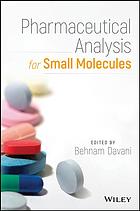

Most ebook files are in PDF format, so you can easily read them using various software such as Foxit Reader or directly on the Google Chrome browser.
Some ebook files are released by publishers in other formats such as .awz, .mobi, .epub, .fb2, etc. You may need to install specific software to read these formats on mobile/PC, such as Calibre.
Please read the tutorial at this link. https://ebooknice.com/page/post?id=faq
We offer FREE conversion to the popular formats you request; however, this may take some time. Therefore, right after payment, please email us, and we will try to provide the service as quickly as possible.
For some exceptional file formats or broken links (if any), please refrain from opening any disputes. Instead, email us first, and we will try to assist within a maximum of 6 hours.
EbookNice Team

Status:
Available0.0
0 reviews
ISBN 10: 1119425018
ISBN 13: 9781119425014
Author: Behnam Davani
A comprehensive introduction for scientists engaged in new drug development, analysis, and approvals
Each year the pharmaceutical industry worldwide recruits thousands of recent science graduates—especially chemistry, analytical chemistry, pharmacy, and pharmaceutical majors—into its ranks. However, because of their limited background in pharmaceutical analysis most of those new recruits find making the transition from academia to industry very difficult. Designed to assist both recent graduates, as well as experienced chemists or scientists with limited regulatory, compendial or pharmaceutical analysis background, make that transition, Pharmaceutical Analysis for Small Molecules is a concise, yet comprehensive introduction to the drug development process and analysis of chemically synthesized, small molecule drugs. It features contributions by distinguished experts in the field, including editor and author, Dr. Behnam Davani, an analytical chemist with decades of technical management and teaching experience in compendial, regulatory, and industry.
This book provides an introduction to pharmaceutical analysis for small molecules (non-biologics) using commonly used techniques for drug characterization and performance tests. The driving force for industry to perform pharmaceutical analyses is submission of such data and supporting documents to regulatory bodies for drug approval in order to market
Chapter 1: Drug Approval Process and Regulatory Requirements
1.1 Introduction
1.2 The Regulatory Process for New Drug Entity
1.3 Good Laboratory Practice for Nonclinical Laboratory Studies
1.4 Validation of Analytical Procedures: Methodology
1.5 FDA Role in the Discovery and Development of New Drug Entities
1.6 FDA Inspectors’ Role in Analytics Relative to Products in the Marketplace
1.7 Conclusions
References
Chapter 2: Pharmacopeias and Compendial Approval Process
2.1 Introduction
2.2 USP History
2.3 Evolution of the Mission of the USP
2.4 The USP Organization
2.5 The USP-NF Revision Process
2.6 Publications of USP
2.7 Relationship between USP and FDA
2.8 USP and the Pharmacopoeias of Europe and Japan
2.9 Harmonization of Pharmacopeial Monographs and General Chapters
2.10 Comparisons between the PDG Process and the ICH Process in Harmonization
2.11 The Special Case of Pharmacopeial Harmonization of Excipients
2.12 Retrospective versus Forward Pharmacopeial Harmonization
2.13 Conclusions and Recommendations
2.14 Final Thoughts
References
Chapter 3: Common Methods in Pharmaceutical Analysis
3.1 Scope
3.2 Analytical Methods
3.3 Spectroscopy Methods
3.4 Other Spectroscopy Methods
3.5 Wet Chemistry Methods
3.6 Performance Methods (Contributed by Oscar Liu)
3.7 Microbiological Methods (Contributed by Roger Dabbah)
3.8 Critical Factors Involved in Microbial Limit Tests and in Sterility Tests
3.9 Harmonization of Pharmacopeial Procedures and Requirement
3.10 Bacterial Endotoxins Test
3.11 Summary
References
Chapter 4: Common Calculations
4.1 Scope
4.2 Calculations (Quantitative Analysis)
4.3 Calculations (System Suitability Parameters)
4.4 Summary
References
Chapter 5: Analytical Method Validation, Verification, and Transfer
5.1 Introduction
5.2 Scope
5.3 Typical Validation Characteristics
5.4 Definition and Determination of Analytical Characteristics
5.5 Types of Analytical Procedures
5.6 Typical Validation Requirement
5.7 Revalidation
5.8 System Suitability
5.9 Forced Degradation (Stressed) Studies
5.10 Analytical Method Verification
5.11 Analytical Method Transfer
5.12 Summary and Conclusion
References
Chapter 6: Specifications
6.1 Scope
6.2 Introduction
6.7 Release Specifications
6.8 Relationship between Release and Shelf-Life Specifications
6.9 Using a Control Chart for Trend Analysis
6.10 Life Cycle Management of Specifications
6.11 Summary
Acknowledgments
References
Chapter 7: Impurities
7.1 Scope
7.2 Definitions
7.3 Classification of Impurities
7.4 Qualification of Impurities
7.5 Other Specific Types of Impurities
7.6 Non-Drug-Related Impurities
7.7 Other Sources of Impurities
7.8 Degradation/Stability Studies
7.9 Summary
References
Chapter 8: Good Documentation Practices
8.1 Scope
8.2 Definition, Purpose, and Importance
8.3 General Rules and Principles of GDocP
8.4 General Tips for Laboratory Notebook Documentation
8.5 Electronic Documents and Electronic Signatures (21 CFR, Part 11)
8.6 US Pharmacopeia General Chapter <1029>
8.7 Rules Governing Medicinal Products in the European Union (Vol. 4: Documentation)
8.8 GDocP Enforcement
8.9 Summary
References
Chapter 9: The Management of Analytical Laboratories
9.1 Introduction
9.2 Principles of Management Applicable to the Laboratory Function
9.3 Management of Analytical Scientists
9.4 Conclusions and Recommendations
References
Chapter 10: Analytical Instrument Qualification
10.1 Introduction
10.2 Definitions
10.3 Qualification: General Flow
10.4 Qualification Strategy: V Model
10.5 Qualification
10.6 Qualification Phases
10.7 Qualification Issues
10.8 Combined Qualification Approach/Commissioning
10.9 Risk-Based Approach
10.10 Calibration/Verification
10.11 Track Performance Verification/Calibration Due Date
10.12 Warning Letters Related to Laboratory Equipment
10.13 Equipment Qualification/Validation and Its Importance
10.14 Examples
10.15 Qualification Status of Existing Equipment/Instrument
10.16 Summary
small molecule bioanalysis
small molecule pharmacokinetics
small molecule experience
molecules and medicine pdf
molecules and medicine
pharmaceutical small molecules
small molecule research
Tags: Behnam Davani, Pharmaceutical, analysis